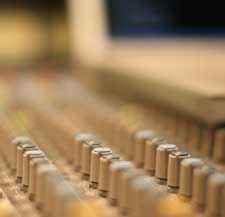» News
Making Room in the Mix

When mixing a large number of instruments and voices the overall sound can get heavy or dense, especially if there are not many parts in the orchestration and everyone is playing / singing the same thing. This is a typical problem we face in churches with large worship teams on the platform and can contribute to the volume level feeling too loud, even when the SPL meter is right where we want it. How can this be prevented? What can be done to fix the mix and bring life back to the music?
The first place to fix the heavy-sound problem is at the source. The sound from the audio system is only as good as the input. Good orchestration, with parts for each instrument or section, breaks up the sound and creates the “space” in the music. Listen to the difference between a piece of music that is well orchestrated and a praise song where everyone is playing off the same chord sheet – the same worship team goes from sounding great to okay. This is why some of the larger “specials” such as Easter and Christmas sound so incredible, yet some worship sets just feel loud and jumbled. Allowing the talent in the worship team to pick out their own lines, orchestrating even on the fly can really open up the sound.
Second, when the source gets to the mixing console, we can separate out the sounds between different instruments and voices. Certain instruments and voices will be the lead, and should be mixed slightly in front of the other inputs, that is, they may be turned up a little more. Other instruments are creating the music bed and should be mixed at a level that, while still heard, they are not standing out as independent sounds. This mix will change from song to song and require constant adjustment to keep the balance for a pleasant, and not heavy, sound.
The next place to work on the problem is the physical placement in the mix. If the sound system is a MONO system (only one speaker or channel of speakers) there is no place to put the sound but out that one speaker. If they system has 2 or 3 channels, such as a STEREO or LCR system, there are more options for where each of the sounds can be placed (which speaker(s) they come out of), thus creating a 2D image with the sounds spread out across the front of the room. Adding more channels, such as surrounds, 5.1, 7.1, adds a third dimension that the sounds can be placed, making the whole room the sound stage.
The fourth tool in the mix is working out the frequency placement of each sound source. Use the equalizer on the console to give each input a specific part of the frequency spectrum to fill. This frequency mixing gives each instrument or voice its sweet spot, while turning down competing sounds from other instruments. For example, while the piano may have notes in the lower frequency range, there are other instruments playing those also – like the Bass Guitar. So rolling off (turning down, not off) the piano’s low end allows the piano to still be the lead instrument volume wise, yet allows the bass guitar notes to shine through at those lower frequencies.
There is much more that can be discussed about each of these tools, watch for future post or talk to us about hosting a training session to learn more.









» Leave a Reply